Online Monitoring of Laser-Generated XUV Radiation Spectra by Surface Reflectivity Measurements with Particle Detectors
Abstract
:1. Introduction
2. Materials and Methods
2.1. Coated XUV Mirrors for 45° Incidence Angle
2.2. Fabrication of the Samples
2.3. Experimental Setup
2.4. Tailored High-Harmonic Generation
2.5. Data Processing
- The measured spectra were converted from wavelength to photon energy scale.
- These spectra were normalized and the offset noise of the spectrometer was subtracted.
- These spectra were interpolated to 1000 data points and multiplied with the tabulated reflectivity values either from iron or CsI.
- Both were then spectrally integrated to obtain the integrated reflected XUV yield . From this, the ratio was calculated.
- The same ratio can be determined using the reflection by the uncoated or coated steel surface onto the Channeltron. Here, the temporally resolved signal must be integrated in a time interval for both surfaces, and its ratio again is .
3. Results and Discussion
3.1. Characterization with Shaped XUV Pulses
3.2. IR Leak Light Detection
4. Conclusions and Outlook
Acknowledgments
Author Contributions
Conflicts of Interest
References
- Zürch, M.; Foertsch, S.; Matzas, M.; Pachmann, K.; Kuth, R.; Spielmann, C. Cancer cell classification with coherent diffraction imaging using an extreme ultraviolet radiation source. J. Med. Imaging 2014, 1. [Google Scholar] [CrossRef] [PubMed]
- Miaja-Avila, L.; Lei, C.; Aeschlimann, M.; Gland, J.L.; Murnane, M.M.; Kapteyn, H.C.; Saathoff, G. Laser-assisted photoelectric effect from surfaces. Phys. Rev. Lett. 2006, 97. [Google Scholar] [CrossRef] [PubMed]
- Krausz, F.; Ivanov, M. Attosecond physics. Rev. Mod. Phys. 2009, 81, 163–234. [Google Scholar] [CrossRef]
- Serrat, C.; Roca, D.; Budesca, J.M.; Seres, J.; Seres, E.; Aurand, B.; Hoffmann, A.; Namba, S.; Kuehl, T.; Spielmann, C. Avalanche of stimulated forward scattering in high harmonic generation. Opt. Express 2016, 24, 8028–8044. [Google Scholar] [CrossRef] [PubMed]
- Zürch, M.; Rothhardt, J.; Hädrich, S.; Demmler, S.; Krebs, M.; Limpert, J.; Tünnermann, A.; Guggenmos, A.; Kleineberg, U.; Spielmann, C. Real-time and sub-wavelength ultrafast coherent diffraction imaging in the extreme ultraviolet. Sci. Rep. 2014, 4. [Google Scholar] [CrossRef] [PubMed]
- Seres, J.; Seres, E.; Landgraf, B.; Ecker, B.; Aurand, B.; Hoffmann, A.; Winkler, G.; Namba, S.; Kuehl, T.; Spielmann, C. Parametric amplification of attosecond pulse trains at 11 nm. Sci. Rep. 2014, 4. [Google Scholar] [CrossRef] [PubMed]
- Heyl, C.M.; Gudde, J.; L’Huillier, A.; Hofer, U. High-order harmonic generation with mu j laser pulses at high repetition rates. J. Phys. B At. Mol. Opt. Phys. 2012, 45. [Google Scholar] [CrossRef]
- Heyl, C.M.; Coudert-Alteirac, H.; Miranda, M.; Louisy, M.; Kovacs, K.; Tosa, V.; Balogh, E.; Varju, K.; L'Huillier, A.; Couairon, A.; et al. Scale-invariant nonlinear optics in gases. Optica 2016, 3, 75–81. [Google Scholar] [CrossRef]
- Peatross, J.; Chaloupka, J.L.; Meyerhofer, D.D. High-order harmonic generation with an annular laserbeam. Opt. Lett. 1994, 19, 942–944. [Google Scholar] [CrossRef] [PubMed]
- Falcone, R.W.; Bokor, J. Dichroic beam splitter for extreme-ultraviolet and visible radiation. Opt. Lett. 1983, 8, 21–23. [Google Scholar] [CrossRef] [PubMed]
- Zhang, Q.; Zhao, K.; Li, J.; Chini, M.; Cheng, Y.; Wu, Y.; Cunningham, E.; Chang, Z.H. Suppression of driving laser in high harmonic generation with a microchannel plate. Opt. Lett. 2014, 39, 3670–3673. [Google Scholar] [CrossRef] [PubMed]
- Kienberger, R.; Goulielmakis, E.; Uiberacker, M.; Baltuska, A.; Yakovlev, V.; Bammer, F.; Scrinzi, A.; Westerwalbesloh, T.; Kleineberg, U.; Heinzmann, U.; et al. Atomic transient recorder. Nature 2004, 427, 817–821. [Google Scholar] [CrossRef] [PubMed]
- Mengxi, W.; Shaohao, C.; Seth, C.; Kenneth, J.S.; Mette, B.G. Theory of strong-field attosecond transient absorption. J. Phys. B 2016, 49. [Google Scholar] [CrossRef]
- Schultze, M.; Wirth, A.; Grguras, I.; Uiberacker, M.; Uphues, T.; Verhoef, A.J.; Gagnon, J.; Hofstetter, M.; Kleineberg, U.; Goulielmakis, E.; et al. State-of-the-art attosecond metrology. J. Electron. Spectrosc. Relat. Phenom. 2011, 184, 68–77. [Google Scholar] [CrossRef]
- Itatani, J.; Quere, F.; Yudin, G.L.; Ivanov, M.Y.; Krausz, F.; Corkum, P.B. Attosecond streak camera. Phys. Rev. Lett. 2002, 88. [Google Scholar] [CrossRef] [PubMed]
- Wang, F.; He, L.X.; Zhai, C.Y.; Shi, W.J.; Zhang, Q.B.; Lan, P.F.; Lu, P.X. Time-dependent phase matching of high-order-harmonic generation. Phys. Rev. A 2015, 92. [Google Scholar] [CrossRef]
- Mashiko, H.; Suda, A.; Midorikawa, K. Focusing coherent soft-X-ray radiation to a micrometer spot size withan intensity of 1014 W/cm2. Opt. Lett. 2004, 29, 1927–1929. [Google Scholar] [CrossRef] [PubMed]
- Henke, B.L.; Gullikson, E.M.; Davis, J.C. X-ray interactions: Photoabsorption, scattering, transmission, and reflection at e = 50–30,000 ev, z = 1–92. At. Data Nucl. Data Tables 1993, 54, 181–342. [Google Scholar] [CrossRef]
- Samson, J.A.R. Photocathodes: Their efficiency and stability. Nucl. Instrum. Methods Phys. Res. 1984, 222, 215–220. [Google Scholar] [CrossRef]
- Hannen, V.; Anielski, D.; Geppert, C.; Jöhren, R.; Kühl, T.; Lochmann, M.; López-Coto, R.; Nörtershäuser, W.; Ortjohann, H.W.; Sánchez, R.; et al. Detection system for forward emitted photons at the experimental storage ring at GSI. J. Instrum. 2013, 8. [Google Scholar] [CrossRef]
- Winters, D.F.A.; Kühl, T.; Schneider, D.H.; Indelicato, P.; Reuschl, R.; Schuch, R.; Lindroth, E.; Stöhlker, T. Laser spectroscopy of the (1s22s2p) 3P0–3P1 level splitting in Be-like krypton. Phys. Scr. 2011, 2011. [Google Scholar] [CrossRef]
- Wen, W.Q.; Lochmann, M.; Ma, X.; Bussmann, M.; Winters, D.F.A.; Nortershauser, W.; Botermann, B.; Geppert, C.; Frommgen, N.; Hammen, M.; et al. Optical measurement of the longitudinal ion distribution of bunched ion beams in the ESR. Nucl. Instrum. Methods in Phys. Res. Sect. A 2013, 711, 90–95. [Google Scholar] [CrossRef]
- Hoffmann, A.; Zürch, M.; Spielmann, C. Extremely nonlinear optics using shaped pulses spectrally broadened in an argon- or sulfur hexafluoride-filled hollow-core fiber. Appl. Sci. 2015, 5, 1310–1322. [Google Scholar] [CrossRef]
- Pfeifer, T.; Spitzenpfeil, R.; Walter, D.; Winterfeldt, C.; Dimler, F.; Gerber, G.; Spielmann, C. Towards optimal control with shaped soft-X-ray light. Opt. Express 2007, 15, 3409–3416. [Google Scholar] [CrossRef] [PubMed]
- Paulus, A.; Winterfeldt, C.; Pfeifer, T.; Walter, D.; Gerber, G.; Spielmann, C. Novel time-of-flight electron spectrometer optimized for time-resolved soft-X-ray photoelectron spectroscopy. Rev. Sci. Instrum. 2006, 77. [Google Scholar] [CrossRef]
- Winterfeldt, C.; Spielmann, C.; Gerber, G. Colloquium: Optimal control of high-harmonic generation. Rev. Mod. Phys. 2008, 80, 117–140. [Google Scholar] [CrossRef]
- Rundquist, A.; Durfee, C.G.; Chang, Z.H.; Herne, C.; Backus, S.; Murnane, M.M.; Kapteyn, H.C. Phase-matched generation of coherent soft X-rays. Science 1998, 280, 1412–1415. [Google Scholar] [CrossRef] [PubMed]
- Pfeifer, T.; Walter, D.; Winterfeldt, C.; Spielmann, C.; Gerber, G. Controlling the spectral shape of coherent soft X-rays. Appl. Phys. B 2005, 80, 277–280. [Google Scholar] [CrossRef]


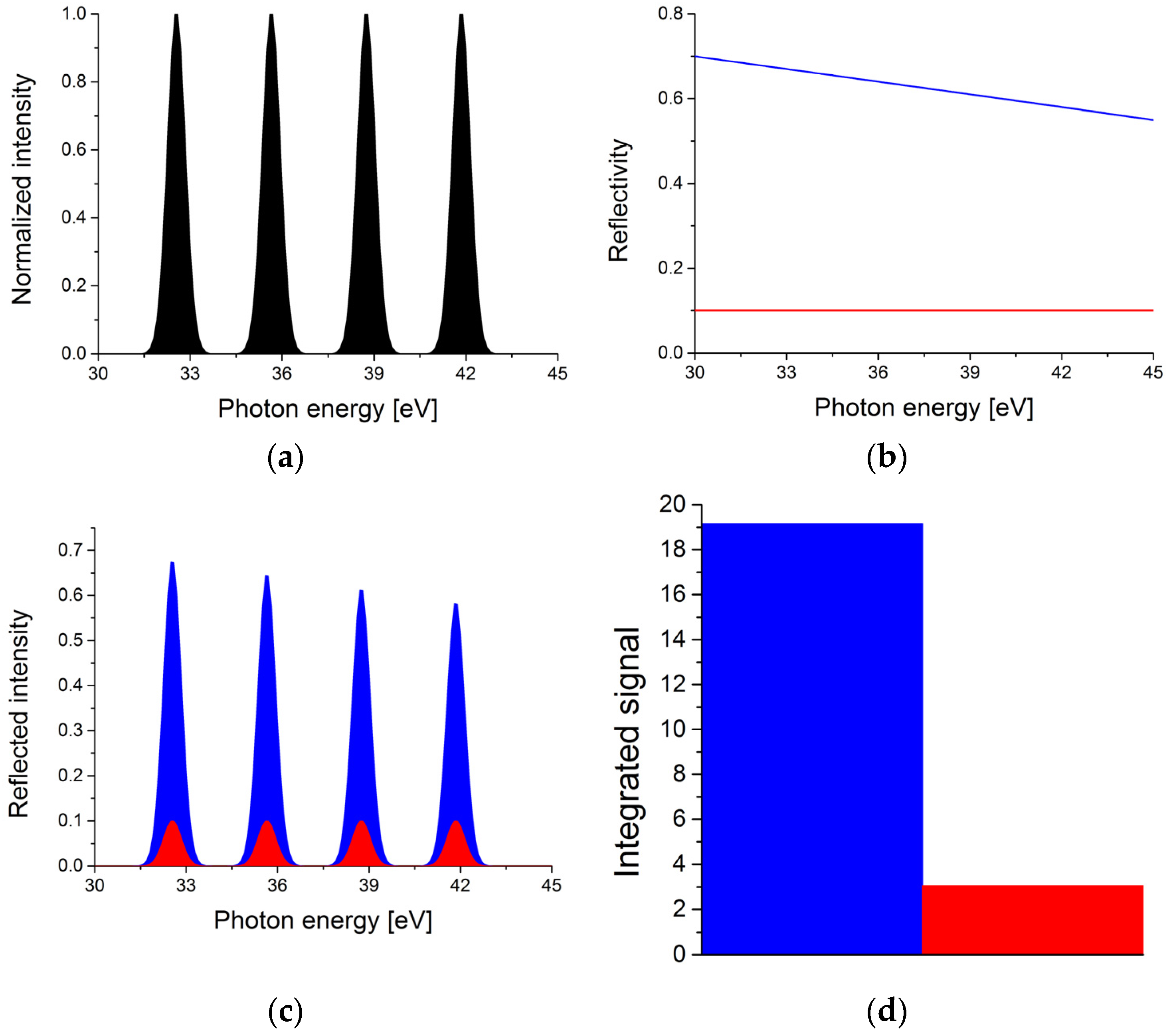
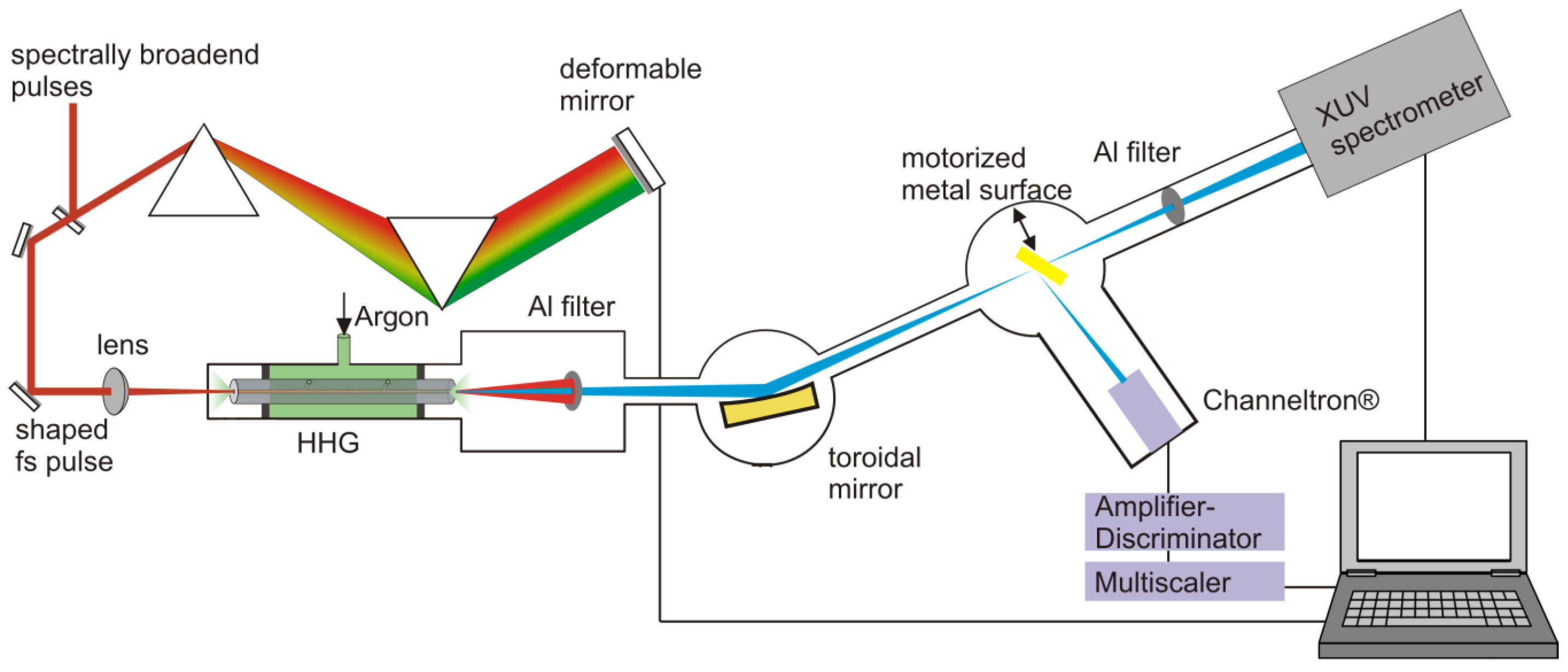

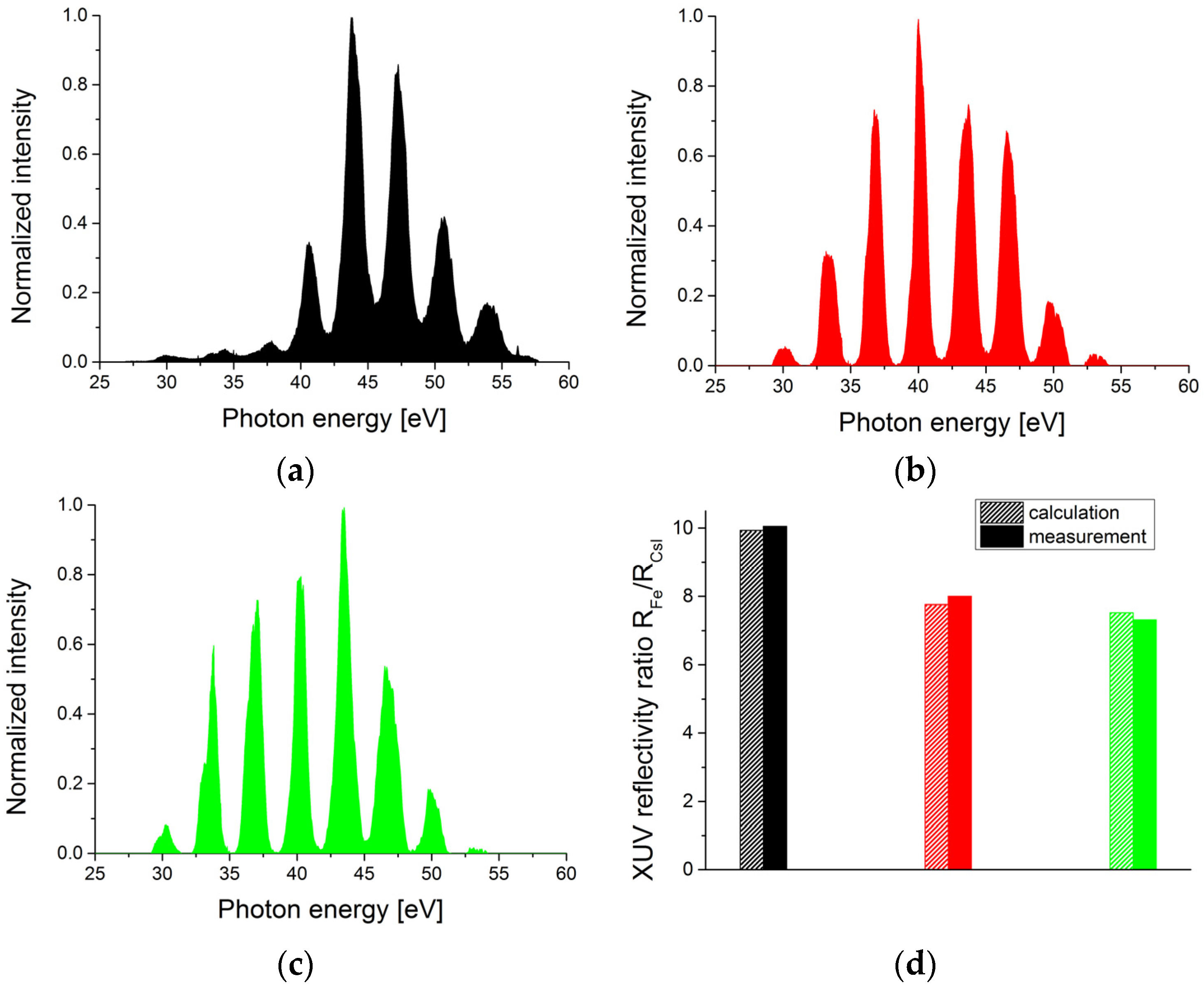
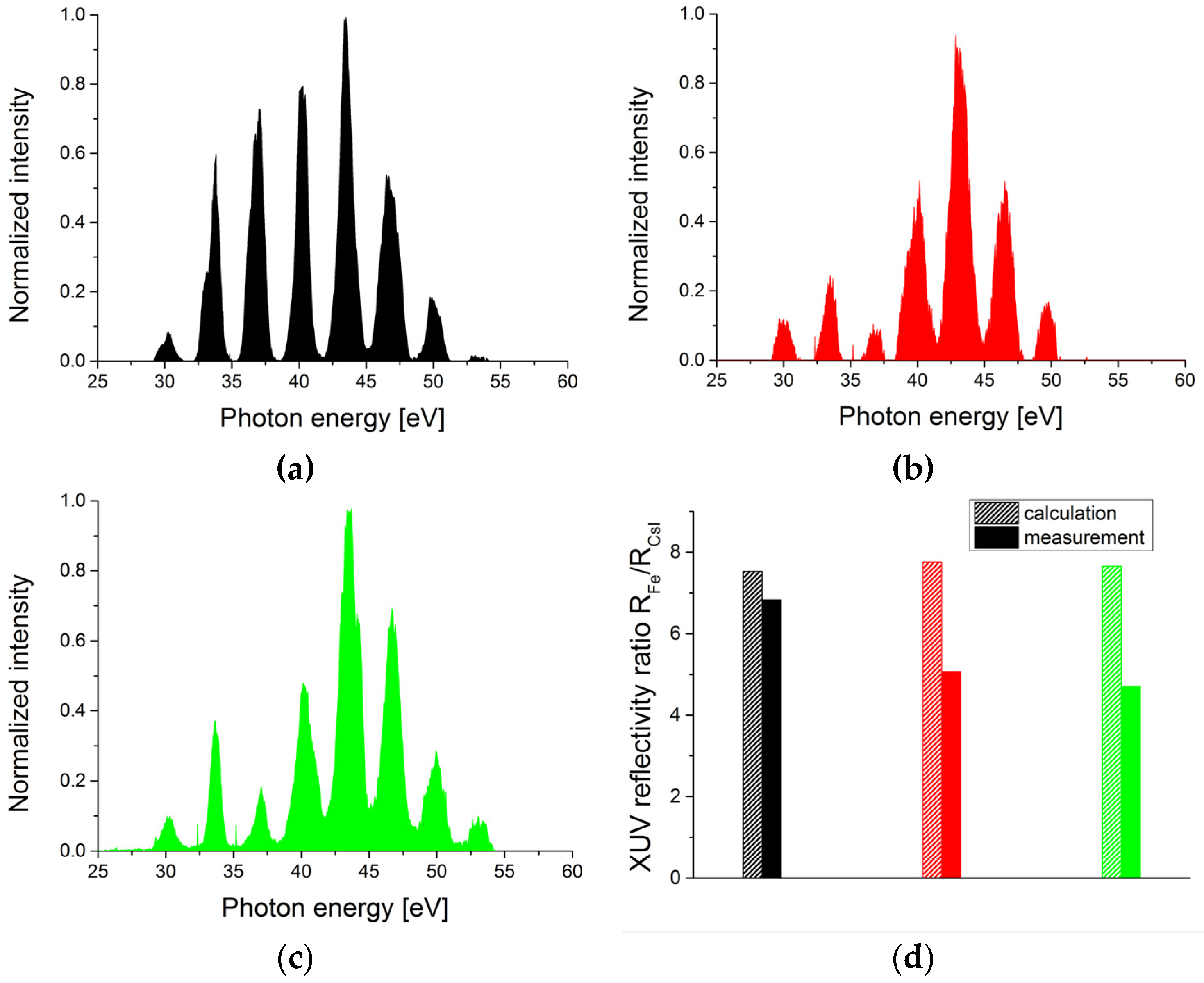
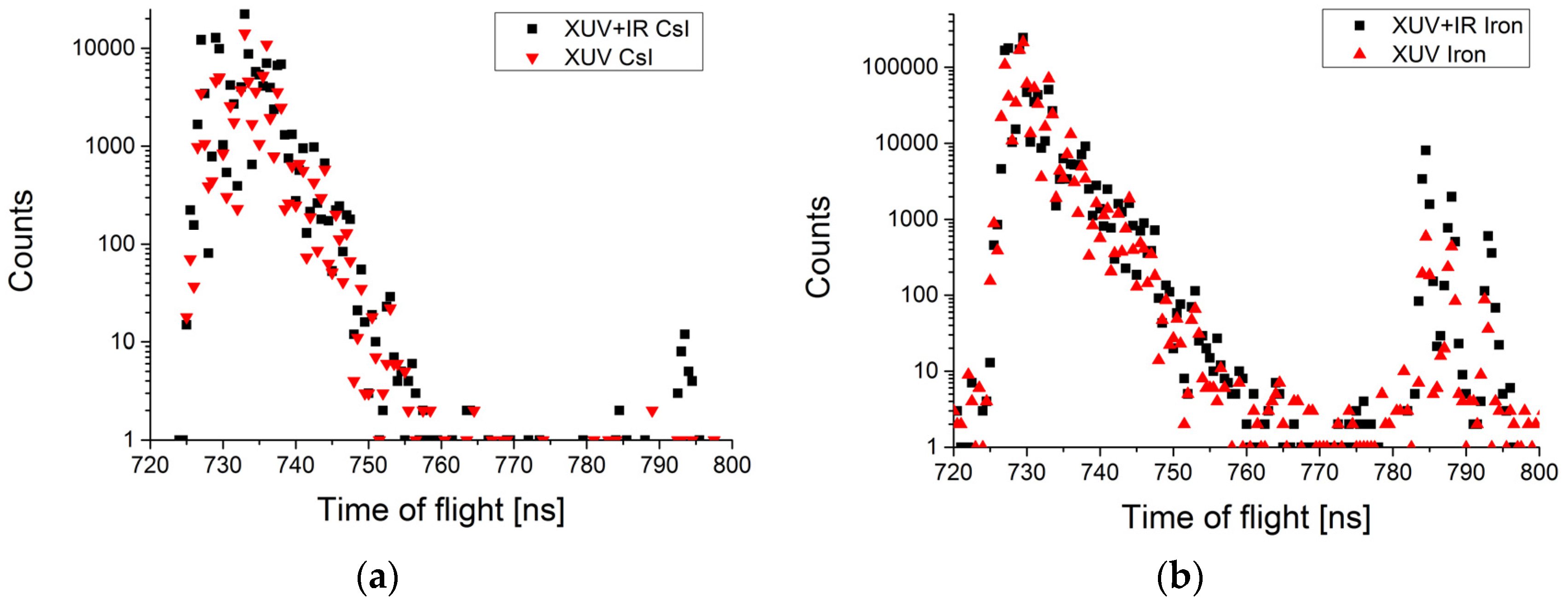
© 2017 by the authors; licensee MDPI, Basel, Switzerland. This article is an open access article distributed under the terms and conditions of the Creative Commons Attribution (CC-BY) license (http://creativecommons.org/licenses/by/4.0/).
Share and Cite
Hoffmann, A.; Egelkamp, C.; Winters, D.; Kühl, T.; Spielmann, C. Online Monitoring of Laser-Generated XUV Radiation Spectra by Surface Reflectivity Measurements with Particle Detectors. Appl. Sci. 2017, 7, 70. https://doi.org/10.3390/app7010070
Hoffmann A, Egelkamp C, Winters D, Kühl T, Spielmann C. Online Monitoring of Laser-Generated XUV Radiation Spectra by Surface Reflectivity Measurements with Particle Detectors. Applied Sciences. 2017; 7(1):70. https://doi.org/10.3390/app7010070
Chicago/Turabian StyleHoffmann, Andreas, Christian Egelkamp, Danyal Winters, Thomas Kühl, and Christian Spielmann. 2017. "Online Monitoring of Laser-Generated XUV Radiation Spectra by Surface Reflectivity Measurements with Particle Detectors" Applied Sciences 7, no. 1: 70. https://doi.org/10.3390/app7010070






